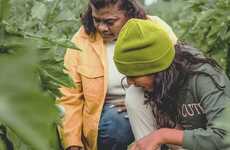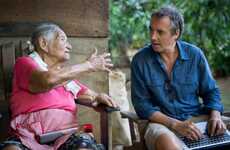
Marine Conservation Organization
Tiana Reid — February 8, 2012 — Social Good
References: ashoka.org & blueventures.org
In 2007, Al Harris, founder of Blue Ventures (BV), was elected for an Ashoka Fellowship -- and it's easy to see why. Indeed, Harris, who has been working on BV since he was a student, has made enormous strides since then. When SocialBusiness.org profiled Blue Ventures in late January, I was amazed at the breadth of this award-winning organization's initiatives. Carbon offsetting, ecotourism, sustainable aquaculture, marine biodiversity conservation, environmental education and community capacity building are all under Al Harris' and Blue Venture's radar.
Here, Al Harris shares his invigorating story on how he started BV, what tribulations he's had to overcome and how the team stays inspire on a day-to-day basis.
Four Questions with Al Harris
1. How did the idea for the business model come about?
Back at university I was something of a biodiversity nut, desperate to find a career as a conservationist. As an undergrad I was lucky enough to receive research funding that took me to some of the poorest parts of the tropical developing world, trips that opened my eyes to the critical need for conservation in some of the wildest places I'd ever seen. Though I was equally struck by the lack of funding available to support conservation in the areas of the world that needed it most. So that sowed the seed of an idea that stayed with me throughout university. But when I came to graduate, given that I was a 23-year-old with absolutely zero experience, no one in their right mind was going to fund me to start my own conservation organisation -- for very good reason! So short of meeting a millionaire philanthropist, social entrepreneurship was really the only solution that I could find for catalyzing conservation -- right from the start we planned it as a tool to provide sustainable finance for conservation, reliably, year in year out. We've had ups and downs along the way (military coups, cyclones -- the usual kind of thing!) but by and large the model has paid off, and we now have an incredible team of over 50 conservationists working worldwide.
2. How did you decide to join this sector?
I set up BV as a student -- so this is the only sector I've ever 'worked' in.
3. How do you get your inspiration?
As a team we get a lot of our inspiration from within, working together and developing concepts for new projects, building on the experience we develop year on year. Also, when your job takes you to some of the most stunningly beautiful places on earth, above and below the waves, you can be pretty spoiled for inspiration. We see both the good and the bad -- pristine coral reefs that no one has ever dived before, as well as ecosystems that are so needlessly degraded that it's almost unbearable to survey them. And then from day to day, after a grueling stint at the computer, inspiration comes from the view from our garden here in Antananarivo, Madagascar's manic capital. On a clear day we can see over 50 kilometers over the chaos of the city, and way beyond to shimmering paddy fields and horizon after horizon of mountains. And every evening the sun sets right in front of us -- it's quite a sight.
4. How do you reset yourself to be creative? Do you have any rituals?
Heading out to those hills beyond the paddy fields, and staying there for as long as it takes!
Here, Al Harris shares his invigorating story on how he started BV, what tribulations he's had to overcome and how the team stays inspire on a day-to-day basis.
Four Questions with Al Harris
1. How did the idea for the business model come about?
Back at university I was something of a biodiversity nut, desperate to find a career as a conservationist. As an undergrad I was lucky enough to receive research funding that took me to some of the poorest parts of the tropical developing world, trips that opened my eyes to the critical need for conservation in some of the wildest places I'd ever seen. Though I was equally struck by the lack of funding available to support conservation in the areas of the world that needed it most. So that sowed the seed of an idea that stayed with me throughout university. But when I came to graduate, given that I was a 23-year-old with absolutely zero experience, no one in their right mind was going to fund me to start my own conservation organisation -- for very good reason! So short of meeting a millionaire philanthropist, social entrepreneurship was really the only solution that I could find for catalyzing conservation -- right from the start we planned it as a tool to provide sustainable finance for conservation, reliably, year in year out. We've had ups and downs along the way (military coups, cyclones -- the usual kind of thing!) but by and large the model has paid off, and we now have an incredible team of over 50 conservationists working worldwide.
2. How did you decide to join this sector?
I set up BV as a student -- so this is the only sector I've ever 'worked' in.
3. How do you get your inspiration?
As a team we get a lot of our inspiration from within, working together and developing concepts for new projects, building on the experience we develop year on year. Also, when your job takes you to some of the most stunningly beautiful places on earth, above and below the waves, you can be pretty spoiled for inspiration. We see both the good and the bad -- pristine coral reefs that no one has ever dived before, as well as ecosystems that are so needlessly degraded that it's almost unbearable to survey them. And then from day to day, after a grueling stint at the computer, inspiration comes from the view from our garden here in Antananarivo, Madagascar's manic capital. On a clear day we can see over 50 kilometers over the chaos of the city, and way beyond to shimmering paddy fields and horizon after horizon of mountains. And every evening the sun sets right in front of us -- it's quite a sight.
4. How do you reset yourself to be creative? Do you have any rituals?
Heading out to those hills beyond the paddy fields, and staying there for as long as it takes!
Trend Themes
1. Marine Conservation - Disruptive innovation opportunity: Develop new technologies and approaches to protect marine biodiversity and promote sustainable aquaculture.
2. Social Entrepreneurship - Disruptive innovation opportunity: Create business models that generate sustainable finance for conservation efforts in underprivileged areas.
3. Ecotourism - Disruptive innovation opportunity: Design immersive and educational ecotourism experiences that raise awareness about environmental conservation.
Industry Implications
1. Conservation Organizations - Disruptive innovation opportunity: Incorporate technology and data-driven solutions to enhance conservation efforts and efficiency.
2. Aquaculture - Disruptive innovation opportunity: Develop sustainable aquaculture practices and technologies to address the growing demand for seafood.
3. Travel and Tourism - Disruptive innovation opportunity: Integrate sustainability practices and eco-friendly initiatives into the travel and tourism industry to promote responsible travel.
3.1
Score
Popularity
Activity
Freshness















